St. Margaret of Clitherow
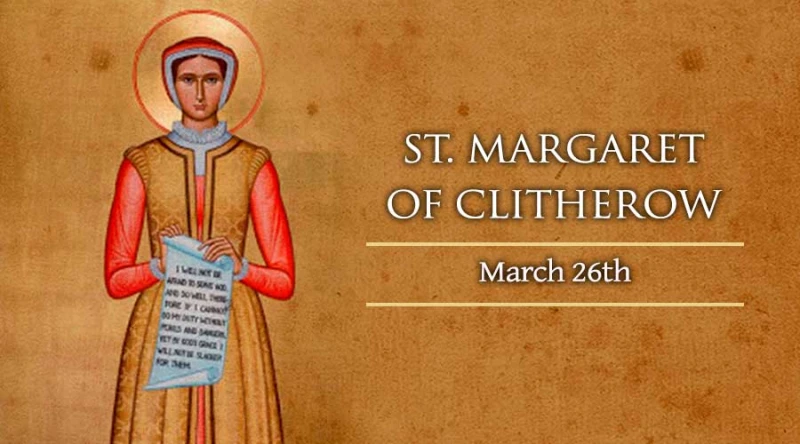
St. Margaret of Clitherow
Feast date: Mar 26
St. Margaret Clitherow was born in Middleton, England around the year 1555 to a protestant family. Margaret was known throughout the town for her wit and good looks, and in 1571 she married John Clitherow, and together they bore two children.
Several years after her marriage to John, Margaret was introduced to the Catholic faith, and converted. She was a zealous defender of Catholicism and hid fugitive priests in her home. Eventually, Margaret was turned in to the sheriff and tried for the crime of harboring Catholic priests.
While Margaret was on trial, many efforts were made to encourage her to deny the Catholic faith, but she held firmly. Finally, Margaret was condemned to be pressed to death upon sharp rocks. She was executed on March 25, 1586.
Pope Paul VI canonized Margaret in 1970.
Solemnity of the Annunciation of the Lord
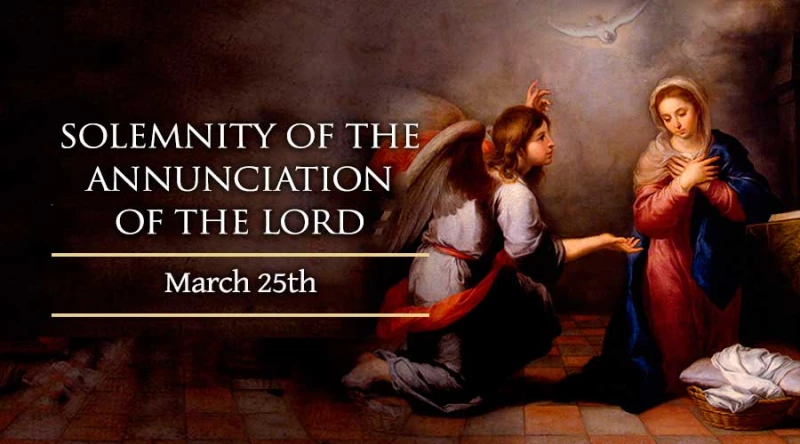
Solemnity of the Annunciation of the Lord
Feast date: Mar 25
The Solemnity of the Annunciation celebrates the coming of the Angel Gabriel to the Virgin Mary to announce to her the special mission God had chosen for her in being the mother of His only son.
We are continually reminded of the importance of this feast to our salvation in various devotional prayers. Two examples that highlight the importance of this feast are the joyous mysteries of the Rosary and the Angelus.
The feast of the Annunciation began to be celebrated on this day during the fourth and fifth centuries, soon after the date for celebrating Christmas was universalized throughout the Church. This feast celebrates the Incarnation of the Second Person of the Trinity and the salvation of all mankind. This point of our salvation was deeply discussed by many of the Church fathers, to explain it to the faithful and to show the deep love God has for us. Some of the Church fathers who wrote on this were St. Athanasius, St. Gregory of Nyssa and St. Augustine.
St. Catherine of Sweden
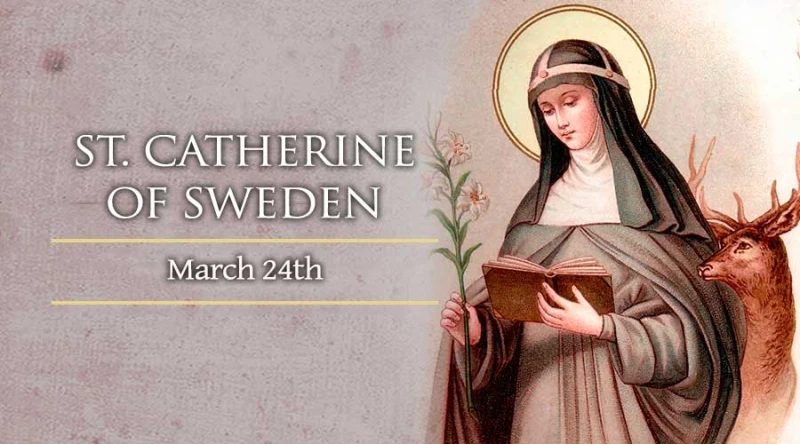
St. Catherine of Sweden
Feast date: Mar 24
St. Catherine was born near the beginning of the fourteenth century to parents Ulfo and St. Bridget of Sweden. At the age of seven, Catherine was sent to the Abbey at Risburgh by her parents and placed under the care of the abbess to receive an education and to build a foundation for her spiritual life.
At the age of 13, Catherine was taken from the abbey and given in marriage to Egard, a German nobleman. Upon meeting Egard, Catherine persuaded him to make a mutual vow of perpetual chastity with her. Catherine and Egard dedicated themselves to the service of God and encouraged each other in works of mortification, prayer and charity.
Around the year 1349, after the death of her father, Catherine accompanied her mother on a pilgrimage to Rome to visit the relics of the Roman Martyrs. The two spent several years living in Rome. In 1373 St. Bridget died and Catherine returned to Sweden with her mother’s body. Two years later, Catherine returned to Rome to promote the cause for her mother’s canonization and to gain approval for a Rule she had written for a group of religious women.
After gaining approval for her rule, Catherine returned to Sweden and became abbess of Vadzstena. Catherine served as abbess of Vadzstena until her death in 1381. During the final 25 years of her life, Catherine was known for her austere lifestyle and her practice of making daily use of the Sacrament of Confession.
St. Catherine was canonized in 1484 by Pope Pius II.
St. Turibius de Mogrovejo
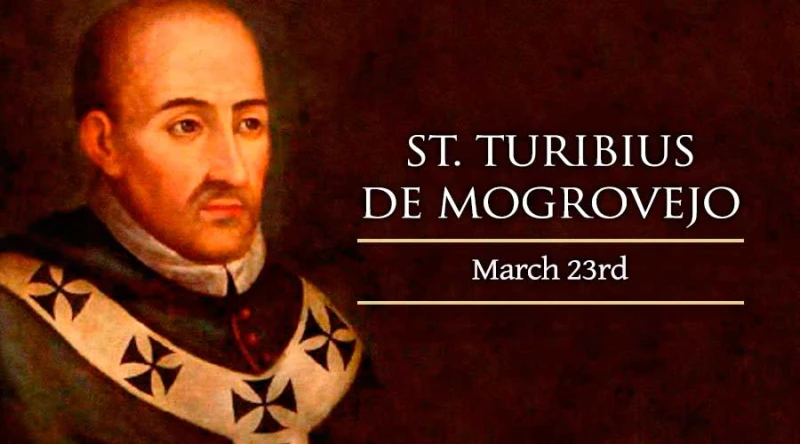
St. Turibius de Mogrovejo
Feast date: Mar 23
Catholics in Latin America and throughout the world will celebrate the life and ministry of St. Turibius of Mogrovejo on March 23. The 16th century bishop upheld the rights of Peru’s indigenous peoples, and became one of the first canonized saints of the Americas.
Turibius was born in Spain during 1538, to a noble family in the kingdom of Leon. He frequently prayed, fasted, and gave to the poor even as a child, and eventually developed the daily habit of praying the Rosary along with the Little Office of the Blessed Virgin Mary.
He went on to study law at the University of Salamanca, and eventually served as a judge for five years in the territory of Granada. His judicial wisdom and diligence drew the attention of King Philip II, who wanted Turibius – who was still a layman – to be consecrated as a missionary archbishop for the Spanish colony of Peru.
Turibius became greatly dismayed, protesting to the king and Church authorities that he was not even a priest and could not possibly accept the charge. In a series of letters, he pled that he was not personally capable of serving as the Archbishop of Lima – nor, he reminded them, did canon law permit a layman to become an archbishop.
Eventually, however, he had little choice but to comply. He was consecrated as a bishop in 1581, at the age of 43, and immediately left for Lima, Peru.
The new archbishop undertook to travel throughout the rugged and mountainous diocese, where he observed many of the worst effects of colonialism – both upon the enslaved and oppressed natives, and on many of the colonists who seemed to have lost their souls in the pursuit of wealth.
He responded with constant prayer and penance, as he traveled throughout his territory administering the sacraments, teaching the Catholic faith, and establishing schools, seminaries and hospitals.
To the indigenous Peruvians, the archbishop was a herald of the Gospel who held their lives as more precious than their country’s supplies of gold and silver. But to the many colonists whose behavior showed no sign of their Catholic origins, he was a prophetic scourge – whose efforts to awaken the public conscience earned him rebukes and opposition.
Turibius ultimately managed to make three visitations of his diocese, under rugged and dangerous conditions, which occupied about half of his 25 years as Archbishop of Lima. He united the Peruvian Church at an administrative level by holding several local councils of its clergy, but was also known to spend days traveling to reach a single individual with the message of Christ.
The archbishop became seriously ill in 1606. He sensed that his death was imminent, and decreed that his possessions should be distributed to the poor. St. Turibius died on March 23, and his body was found to be incorrupt the next year. He was declared a saint in 1726, and is now regarded as the patron of native peoples’ rights and Latin American bishops.
St. Lea
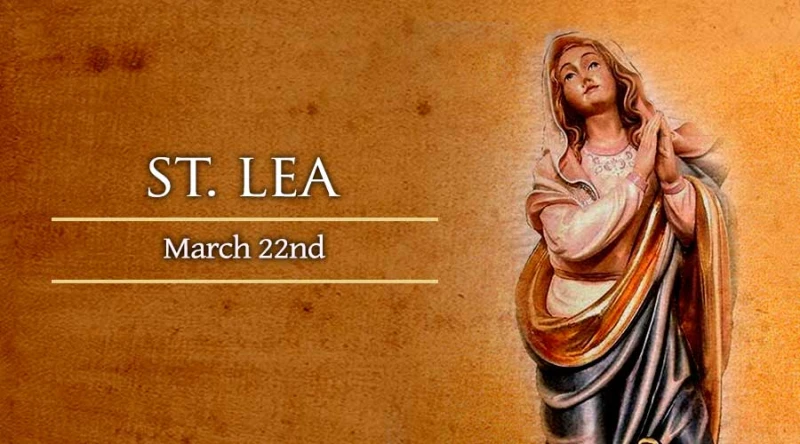
St. Lea
Feast date: Mar 22
March 22 is the liturgical memorial of Saint Lea of Rome, a fourth-century widow who left her wealth behind, entered consecrated life, and attained great holiness through asceticism and prayer.
Though not well-known as a figure of devotion in modern times, she was acknowledged as a saint on the testimony of her contemporary Saint Jerome, who wrote a brief description of Lea’s life after she had died.
Jerome, a scholarly monk best known for his Latin translation of the Bible (the Vulgate), is the Church’s only source of information on St. Lea, whose biographical details are unknown. St. Jerome eulogized her in a letter written during the year 384 to his student and spiritual directee Marcella, another Roman consecrated woman who had left her aristocratic life behind after being widowed.
It is clear from his letter that Lea was a mutual friend to both Jerome and Marcella. Jerome states that his account is written to “hail with joy the release of a soul which has trampled Satan under foot, and won for itself, at last, a crown of tranquility.” Jerome also contrasts the life of “our most saintly friend” with that of the late pagan public official Praetextatus, held up by Jerome as a cautionary example.
“Who,” Jerome begins, “can sufficiently eulogize our dear Lea’s mode of living? So complete was her conversion to the Lord that, becoming the head of a monastery, she showed herself a true mother to the virgins in it, wore coarse sackcloth instead of soft raiment, passed sleepless nights in prayer, and instructed her companions even more by example than by precept.”
Jerome describes how Lea, in her great humility, “was accounted the servant of all … She was careless of her dress, neglected her hair, and ate only the coarsest food. Still, in all that she did, she avoided ostentation that she might not have her reward in this world.”
Jerome’s letter goes on to compare her fate to that of Praetextus – who died in the same year as Lea, after spending his life promoting a return to Rome’s ancient polytheistic pagan religion. The monk retells Jesus’ parable of Lazarus and Dives, with Lea in the place of the poor and suffering man.
Lea, Jerome says, is “welcomed into the choirs of the angels; she is comforted in Abraham’s bosom. And, as once the beggar Lazarus saw the rich man, for all his purple, lying in torment, so does Lea see the consul, not now in his triumphal robe but clothed in mourning, and asking for a drop of water from her little finger.”
Thus Lea, “who seemed poor and of little worth, and whose life was accounted madness,” triumphs in salvation. But the punishment of infidelity falls on the consul-elect – who had led a triumphant procession just before his death, and been widely mourned afterward.
Jerome ends his letter by urging Marcella to remember the lesson of St. Lea’s life: “We must not allow … money to weigh us down, or lean upon the staff of worldly power. We must not seek to possess both Christ and the world. No; things eternal must take the place of things transitory; and since, physically speaking, we daily anticipate death, if we wish for immortality we must realize that we are but mortal.”
St. Nicholas of Flue
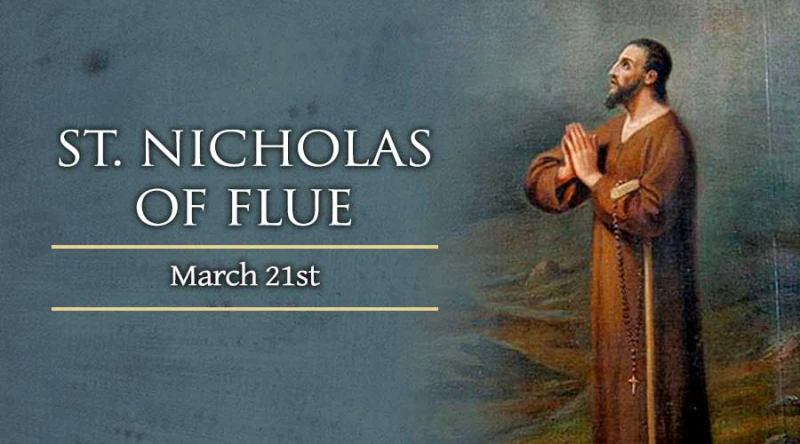
St. Nicholas of Flue
Feast date: Mar 21
Today, the universal church celebrates the feast of St. Nicholas of Flue. During his lifetime, the Swiss saint had 10 children, became a hermit and later prevented a civil war.
Nicholas was born in 1417 near the Lake of Lucerne in Switzerland. In addition to his duties as a husband and a father, Nicholas donated his talents and time selflessly to the community and always strove to give an excellent moral example to all.
The saint was also able to devote much of his private life to developing a strong relationship with the Lord. He had a strict regime of fasting and he spent a great deal of time in contemplative prayer.
Around the year 1467, when he was 50 years old, Nicholas felt called to retire from the world and become a hermit. His wife and children gave their approval, and he left home to live in a hermitage a few miles away. While living as a hermit, Nicholas soon gained a wide reputation on account of his personal sanctity and many people sought him out to request his prayers and spiritual advice.
Nicholas lived the quiet life of a hermit for 13 years. However in 1481, a dispute arose between the delegates of the Swiss confederates at Stans and a civil war seemed imminent. The people called on Nicholas to settle the dispute, so he drafted several proposals which everyone eventually agreed on.
Nicholas’ work prevented civil war and solidified the country of Switzerland. But, as a true hermit, he then returned to his hermitage after settling the dispute.
He died six years later on March 21, 1487 surrounded by his wife and children.
St. Enda
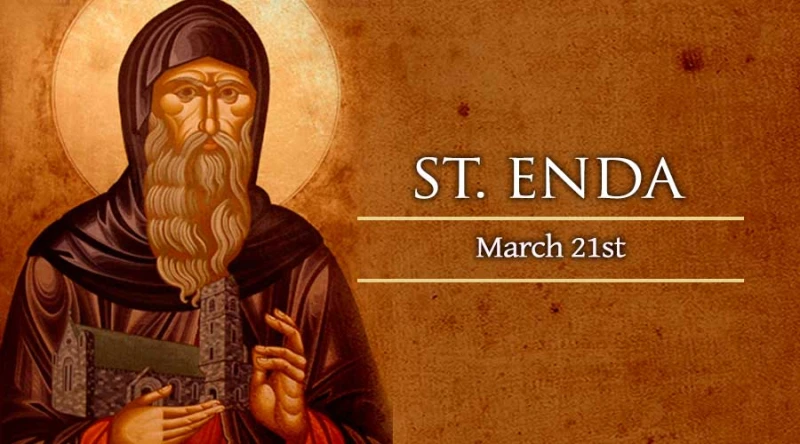
St. Enda
Feast date: Mar 21
On March 21, four days after the feast day of Ireland’s patron Saint Patrick, the Catholic Church honors Saint Enda of Aran, a warrior-turned-monk considered to be one of the founders of Irish monasticism.
Born during the fifth century, Enda inherited control of a large territory in present-day Northern Ireland from his father Conall. His sister Fanchea, however, had already embraced consecrated religious life with a community in Meath, and looked unfavorably on the battles and conquests of her brother.
Enda is said to have made a deal with his sister, promising to change his ways if he could marry one of the young women of her convent. But this was a ruse on Fanchea’s part, as the promised girl soon died. Fanchea forced him to view the girl’s corpse, to teach him that he, too, would face death and judgment.
In this way, Fanchea – whom the Church also remembers as a saint – succeeded in turning her brother not only from violence, but even from marriage. He left Ireland for several years, during which time he became a monk and was ordained as a priest.
Upon his return to Ireland, he petitioned his King Aengus of Munster – who was married to another of Enda’s sisters – to grant him land for a monastic settlement on the Aran Islands, a beautiful but austere location near Galway Bay off Ireland’s west coast.
During its early years, Enda’s island mission had around 150 monks. As the community grew, he divided up the territory between his disciples, who founded their own monasteries to accommodate the large number of vocations.
Enda did not found a religious order in the modern sense, but he did hold a position of authority and leadership over the monastic settlements of Aran – which became known as “Aran of the Saints,” renowned for the monks’ strict rule of life and passionate love for God.
While living on an Irish island, Enda’s monks imitated the asceticism and simplicity of the earliest Egytian desert hermits.
The monks of Aran lived alone in their stone cells, slept on the ground, ate together in silence, and survived by farming and fishing. St. Enda’s monastic rule, like those of St. Basil in the Greek East and St. Benedict in the Latin West, set aside many hours for prayer and the study of scripture.
During his own lifetime, Enda’s monastic settlement on the Aran islands became an important pilgrimage destination, as well as a center for the evangelizations of surrounding areas. At least two dozen canonized individuals had some association with “Aran of the Saints.”
St. Enda himself died in old age around the year 530. An early chronicler of his life declared that it would “never be known until the day of judgment, the number of saints whose bodies lie in the soil of Aran,” on account of the onetime-warrior’s response to God’s surprising call.
